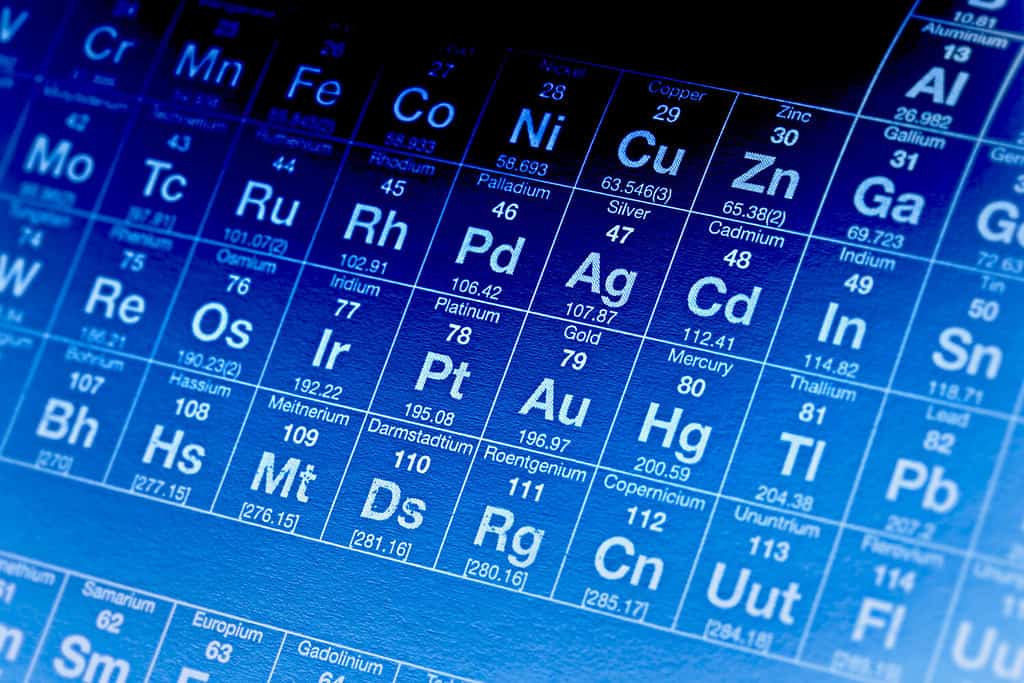What’s the molar mass of magnesium?
Magnesium, symbolized as Mg and positioned as atomic number 12 on the periodic table, possesses a significance far greater than you might think. This mineral element occurs worldwide and plays a major role in the proper functioning of the human body. But that’s not all. Magnesium is indispensable for all life forms on Earth in one way or another.
Understanding magnesium’s molar mass allows us to grasp its profound impact, so we can make the planet a better place to live. That’s why, in this article, we’ll dive deeper into the concept of molar mass. We’ll explore the specific molar mass of magnesium and explain exactly why it matters.
Molar Mass of Magnesium

For the element magnesium, the molar mass comes out to be approximately 24.31 grams per mole.
©Ground Picture/Shutterstock.com
For the element magnesium, the molar mass comes out to be approximately 24.31 grams per mole. A mole of any substance corresponds to 6.022 x 10^23 units of that substance, as stated by Avogadro’s number.
Avogadro’s number is a special conversion factor in chemistry. It helps us switch between the number of particles and moles. And this number is really big—about 6.022 x 10^23. The number is so big that if you started counting right now and counted day and night, it would take you thousands and thousands of years to reach that number.
Breaking Down Avogadro’s Number
The “x 10^23” part tells us how many zeros to add after the 6.022. In this case, it means we need to add 23 zeros. If we were to write out the entire number, it would be 602 sextillions, 200 quintillions. And it would look like 602,200,000,000,000,000,000,000. Now you can see why it’s impossible to count to this number in your lifetime. The number is so big because it counts super tiny atoms and molecules.
Avogadro connects the tiny world of individual particles to the larger world we can measure. With this number, we can determine how many atoms or molecules are in a specific amount of a substance. Just like we know there are 12 eggs in a dozen, this number allows us to know how much magnesium is in a mole. This allows us to make calculations and measurements in chemistry.
What Is Molar Mass Exactly?

Molar mass is a chemistry term that lets us know how much a substance, like magnesium, weighs.
©isak55/Shutterstock.com
Molar mass is a term in chemistry that tells us how much one mole of a certain substance weighs. This measure allows scientists to consistently compare the masses of different substances, no matter where they are in the universe. Molar mass is found by adding up the weights of all the atoms in a molecule of that substance, and it’s measured in grams per mole (g/mol).
Mole
In chemistry, there’s a special counting unit called a mole (abbreviated as mol). It helps us count tiny particles, such as atoms or molecules, which are too small to count individually. And molar mass is measured in grams per mole (g/mol). The measurement serves as a bridge between the microscopic world of atoms and the macroscopic world we observe.
A mole is like a big container that makes it possible to count tiny particles, such as atoms. To help you visualize it, imagine a box filled with lots of tiny marbles. The box represents one mole of particles. Just as we can count marbles in a box, we can count atoms or molecules using the mole concept.
Why It Matters
Understanding molar mass holds significant importance, particularly for individuals working in scientific fields such as chemistry and biology. With this knowledge, scientists can make precise calculations and predictions when conducting experiments, allowing for greater accuracy and reliability in their findings.
The Role of Magnesium in the Human Body

Magnesium supports over 300 biochemical reactions within the human body.
©Life science/Shutterstock.com
Magnesium is more than just an element; it plays a crucial role in maintaining our overall health and well-being. It helps with over 300 chemical reactions. For instance, it helps support healthy muscle and nerve function, strengthens the immune system, and ensures a steady heartbeat. Additionally, magnesium aids in controlling blood glucose levels, and boost energy and protein production.
Sleep Aid

Magnesium is a natural sleep aid that promotes a state of rest.
©Hannamariah/Shutterstock.com
Magnesium has recently gained recognition as a natural sleep aid that may be able to enhance sleep quality. The element shows promise in improving various aspects of sleep, including duration, efficiency, and how quickly we fall asleep.
How does it work? Magnesium works by calming the nerves and reducing excitability in the brain, which helps promote relaxation and a state of sleepiness. It also increases the activity of a neurotransmitter called GABA, which further helps to regulate brain activity and induce relaxation.
Additionally, magnesium blocks certain receptors that transmit pain signals, which can disrupt sleep when they’re too active. It’s possible that it may also have a role in the production of melatonin, the hormone that controls our sleep-wake cycles.
Magnesium in the Environment

The eighth most abundant element in the Earth’s crust is magnesium.
©iStock.com/Thaweesak Saengngoen
The eighth most abundant element in the Earth’s crust is magnesium. The #1 most abundant element in the Earth’s crust is oxygen.
Oxygen makes up approximately 46% of the Earth’s crust by mass. It’s followed by silicon, the second most abundant element, accounting for around 28% of the crust. Other abundant elements in the Earth’s crust include aluminum, iron, calcium, sodium, and potassium.
Magnesite and dolomite are two types of rocks that contain magnesium. They are special rocks because they have a significant amount of magnesium.
Magnesium and Plants

Magnesium is essential for the growth and development of plants. Without magnesium, plants wouldn’t be able to photosynthesize, which is fundamental to their survival.
Magnesium is a major component of chlorophyll, the green pigment found in the leaves of plants. When leaves change color in the Fall, it’s because they stop producing chlorophyll.
Chlorophyll is responsible for capturing light energy and converting it into chemical energy through photosynthesis. During photosynthesis, plants use the energy from sunlight, carbon dioxide, and water to produce glucose and oxygen. This process is fueled by chlorophyll, which relies on magnesium to function properly.
Since plants are like the foundation for food chains, the presence of magnesium has big implications for ecosystems. Plants become food for herbivores, which are then consumed by carnivores (meat-eating animals). Without magnesium and photosynthesis, plants would struggle to grow, impacting the entire ecosystem.
Soil Fertility

Magnesium-rich soil provides favorable conditions for plant growth.
©sasirin pamai/Shutterstock.com
Magnesium not only supports plant growth but also contributes to soil fertility. Magnesium-rich soil provides favorable conditions for plant growth, ensuring healthy ecosystems. Moreover, magnesium is involved in enzyme activation and other biochemical reactions within organisms, playing a role in their overall well-being.
Dietary Sources of Magnesium

Legumes, like black beans, chickpeas, and lentils, are a great source of magnesium.
©iStock.com/piyaset
So where can we source magnesium? Thankfully, it’s not hard to find. A few dietary sources include green leafy vegetables, nuts, seeds, and whole grains.
Here are five more dietary sources of magnesium:
- Legumes: Legumes like black beans, chickpeas, and lentils are excellent sources of magnesium.
- Fish: Certain types of fish, such as salmon, mackerel, and halibut, contain good amounts of magnesium.
- Avocado: Avocado is a delicious fruit that not only provides healthy fats but also contributes to your magnesium intake.
- Dark chocolate: A treat that can be good for you! Dark chocolate, with a high cocoa content, is a decent source of magnesium.
- Bananas: These versatile fruits not only provide potassium but also contain some magnesium.
These sources are just the start. There are plenty of other dietary sources of magnesium you can explore.
More Sources of Magnesium

The sea is a rich source of magnesium.
©AlexLinck/Shutterstock.com
Guess what? The sea isn’t just full of salt. It also contains a significant amount of magnesium.
Moreover, there’s an intriguing phenomenon where old seawater gets trapped underground, forming brine deposits rich in magnesium. Over time, these brine deposits concentrate and become reservoirs of concentrated magnesium.
Magnesium is also found in many rocks and minerals, like Epsomite. This mineral forms in places where water has evaporated or as a result of the weathering of certain minerals. You can also find magnesium in carnallite. This mineral is found in salt deposits and contains both potassium and magnesium.
And there’s magnesium in super-hot rocks from volcanoes, like olivine, which is rich in magnesium and iron, along with oxygen and silicon. Olivine is a type of mineral that is often found in igneous rocks, such as basalt and peridotite. These rocks are common in volcanic areas or deep within the Earth’s mantle.
10 Industrial Applications for Magnesium

Since magnesium is a lightweight metal, it’s often used in the aerospace industry.
©Matthew Zuech/Shutterstock.com
Magnesium is one-third lighter than aluminum. This makes it the go-to choice for building helicopters and airplanes. But that’s not all.
Magnesium is a hit among various industries for a bunch of reasons. It has an impressive strength-to-weight ratio, making it strong and lightweight at the same time. Plus, it’s super easy to work with, resistant to corrosion, and conducts both heat and electricity. It’s also biocompatible, fire-resistant, and 100% recyclable.
Here’s a list of some of the most common industrial applications with magnesium:
- Aerospace industry
- Automotive industry
- Electronics and gadgets
- Sports equipment
- Medical applications
- Construction materials
- Power tools and machinery
- Packaging and transportation
- Chemical production
- Fireworks and pyrotechnics
Magnesium has made its mark in the world of tennis. High-performance tennis racquets often incorporate magnesium into their design. By leveraging magnesium’s lightweight and robust properties, these racquets offer players a winning combination of dexterity, power, and control on the court.
Elements with Similar Molar Mass
Some other elements and compounds have molar masses close to that of magnesium.
| Element/Compound | Symbol | Molar Mass |
|---|---|---|
| Magnesium | Mg | 24.31 |
| Aluminum | Al | 26.98 |
| Silicon | Si | 28.09 |
| Phosphourous | P | 30.97 |
| Sulfur | S | 32.07 |
| Phosphorous | Cl | 35.45 |
| Sodium | Na | 22.99 |
| Carbon Dioxide | CO2 | 44.01 |
Carbon dioxide is a compound, not a single element like the others on the list. This means its molar mass is calculated by adding up the molar masses of its atoms (one carbon atom and two oxygen atoms). While its molar mass of 44.01 g/mol is nearly double that of magnesium (24.31 g/mol), we included it in the table to illustrate the impact of adding atoms to form a molecule. Forming compounds can significantly increase the molar mass compared to individual elements.
Final Thoughts on Molar Mass of Magnesium
Recognizing the molar mass of magnesium as approximately 24.31 grams per mole is a real game-changer in scientific fields like chemistry and biology. It’s not just another random fact to cram into your brain; it’s a way to unlock real-world applications. With this knowledge, scientists can perform calculations with pinpoint precision and make predictions.
The more we know about this element, the better off the world will be. Magnesium is crucial in over 300 biochemical reactions within our human bodies. And it’s even gaining recognition as a possible sleep aid. It’s also a major player in the environment, working behind the scenes to support plant growth and photosynthesis.
And let’s not forget about its industrial applications. Magnesium is lightweight yet strong and has a knack for resisting corrosion. Plus, it conducts electricity effortlessly. Let’s give it up for magnesium, the element worth its weight in molar mass!
The photo featured at the top of this post is © Beyond This/Shutterstock.com
Thank you for reading! Have some feedback for us? Contact the AZ Animals editorial team.







